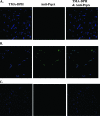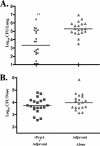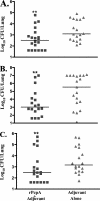Streptococcus pneumoniae surface protein PcpA elicits protection against lung infection and fatal sepsis
- PMID: 18391008
- PMCID: PMC2423059
- DOI: 10.1128/IAI.01126-07
Streptococcus pneumoniae surface protein PcpA elicits protection against lung infection and fatal sepsis
Abstract
Previous studies have suggested that pneumococcal choline binding protein A (PcpA) is important for the full virulence of Streptococcus pneumoniae, and its amino acid sequence suggests that it may play a role in cellular adherence. PcpA is under the control of a manganese-dependent regulator and is only expressed at low manganese concentrations, similar to those found in the blood and lungs. PcpA expression is repressed under high manganese concentrations, similar to those found in secretions. In this study, we have demonstrated that PcpA elicits statistically significant protection in murine models of pneumonia and sepsis. In the model of pneumonia with each of four challenge strains, statistically fewer S. pneumoniae cells were recovered from the lungs of mice immunized with PcpA and alum versus mice immunized with alum only. The immunizations reduced the median CFU by 4- to 400-fold (average of 28-fold). In the model of sepsis using strain TIGR4, PcpA expression resulted in shorter times to become moribund and subcutaneous immunization with PcpA increased survival times of mice infected with wild-type PcpA-expressing pneumococci.
Figures







Similar articles
-
Mn2+-dependent regulation of multiple genes in Streptococcus pneumoniae through PsaR and the resultant impact on virulence.Infect Immun. 2006 Feb;74(2):1171-80. doi: 10.1128/IAI.74.2.1171-1180.2006. Infect Immun. 2006. PMID: 16428766 Free PMC article.
-
Human antibodies to PhtD, PcpA, and Ply reduce adherence to human lung epithelial cells and murine nasopharyngeal colonization by Streptococcus pneumoniae.Infect Immun. 2014 Dec;82(12):5069-75. doi: 10.1128/IAI.02124-14. Epub 2014 Sep 22. Infect Immun. 2014. PMID: 25245804 Free PMC article.
-
PcpA of Streptococcus pneumoniae mediates adherence to nasopharyngeal and lung epithelial cells and elicits functional antibodies in humans.Microbes Infect. 2012 Oct;14(12):1102-10. doi: 10.1016/j.micinf.2012.06.007. Epub 2012 Jul 14. Microbes Infect. 2012. PMID: 22796387 Free PMC article.
-
PcpA Promotes Higher Levels of Infection and Modulates Recruitment of Myeloid-Derived Suppressor Cells during Pneumococcal Pneumonia.J Immunol. 2016 Mar 1;196(5):2239-48. doi: 10.4049/jimmunol.1402518. Epub 2016 Feb 1. J Immunol. 2016. PMID: 26829988 Free PMC article.
-
Antibodies to PcpA and PhtD protect mice against Streptococcus pneumoniae by a macrophage- and complement-dependent mechanism.Hum Vaccin Immunother. 2018 Feb 1;14(2):489-494. doi: 10.1080/21645515.2017.1403698. Epub 2017 Dec 14. Hum Vaccin Immunother. 2018. PMID: 29135332 Free PMC article.
Cited by
-
Streptococcus pneumoniae in biofilms are unable to cause invasive disease due to altered virulence determinant production.PLoS One. 2011;6(12):e28738. doi: 10.1371/journal.pone.0028738. Epub 2011 Dec 8. PLoS One. 2011. PMID: 22174882 Free PMC article.
-
Efficacy of opsonic and nonopsonic serotype 3 pneumococcal capsular polysaccharide-specific monoclonal antibodies against intranasal challenge with Streptococcus pneumoniae in mice.Infect Immun. 2009 Apr;77(4):1502-13. doi: 10.1128/IAI.01075-08. Epub 2009 Jan 21. Infect Immun. 2009. PMID: 19168739 Free PMC article.
-
Otitis media: recent advances in otitis media vaccine development and model systems.Front Microbiol. 2024 Jan 24;15:1345027. doi: 10.3389/fmicb.2024.1345027. eCollection 2024. Front Microbiol. 2024. PMID: 38328427 Free PMC article. Review.
-
Prevalence and clonal distribution of pcpA, psrP and Pilus-1 among pediatric isolates of Streptococcus pneumoniae.PLoS One. 2012;7(7):e41587. doi: 10.1371/journal.pone.0041587. Epub 2012 Jul 25. PLoS One. 2012. PMID: 22848535 Free PMC article.
-
A bivalent pneumococcal histidine triad protein D-choline-binding protein A vaccine elicits functional antibodies that passively protect mice from Streptococcus pneumoniae challenge.Hum Vaccin Immunother. 2016 Nov;12(11):2946-2952. doi: 10.1080/21645515.2016.1202389. Hum Vaccin Immunother. 2016. PMID: 27392182 Free PMC article. Clinical Trial.
References
-
- Balachandran, P., A. Brooks-Walter, A. Virolainen-Julkunen, S. K. Hollingshead, and D. E. Briles. 2002. Role of pneumococcal surface protein C in nasopharyngeal carriage and pneumonia and its ability to elicit protection against carriage of Streptococcus pneumoniae. Infect. Immun. 702526-2534. - PMC - PubMed
-
- Bogaert, D., R. H. Veenhoven, M. Sluijter, W. J. W. Wannet, G. T. Rijkers, T. J. Mitchell, S. C. Clarke, W. H. F. Goessens, A. G. Schilder, E. A. M. Sanders, R. de Groot, and P. W. M. Hermans. 2005. Molecular epidemiology of pneumococcal colonization in response to pneumococcal conjugate vaccination in children with recurrent acute otitis media. J. Clin. Microbiol. 4374-83. - PMC - PubMed
-
- Braun, L., and P. Cossart. 2000. Interactions between Listeria monocytogenes and host mammalian cells. Microbes Infect. 2803-811. - PubMed
-
- Briles, D. E. 2004. Protection of the elderly from pneumococcal pneumonia with a protein-based vaccine? Mech. Ageing Dev. 125129-131. - PubMed
Publication types
MeSH terms
Substances
Grants and funding
LinkOut - more resources
Full Text Sources
Other Literature Sources
Medical
Molecular Biology Databases

